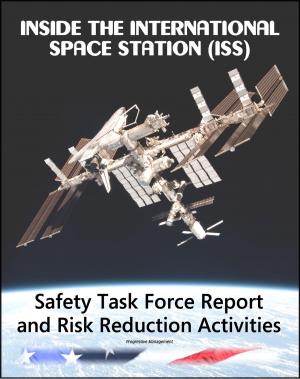Next-Generation Microbiological Requirements for Space Flight: Human Research Program, Space Human Factors & Habitability - Pathogens, Potable Water, Life Sciences, Manned Mars Missions
Nonfiction, Health & Well Being, Medical, Medical Science, Microbiology, Science & Nature, Technology, Aeronautics & Astronautics| Author: | Progressive Management | ISBN: | 9781310091537 |
| Publisher: | Progressive Management | Publication: | April 30, 2015 |
| Imprint: | Smashwords Edition | Language: | English |
| Author: | Progressive Management |
| ISBN: | 9781310091537 |
| Publisher: | Progressive Management |
| Publication: | April 30, 2015 |
| Imprint: | Smashwords Edition |
| Language: | English |
Professionally converted for accurate flowing-text e-book format reproduction, this NASA report details microbiological requirements for spaceflight. Microbiological requirements that mitigate risk to the crew during space flight missions are periodically updated to reflect changes in the scientific understanding of microbial pathogenicity, our knowledge of the response of microorganisms to the space flight environment, effects of space flight upon human immunity, and advances in monitoring technology. Three expert panels held from 2011 through 2013 performed a review of microbiological requirements, based on new knowledge and available technologies. These panels focused on requirements associated with potable water, space flight food, and vehicle air and surfaces specifically described in NASA Space Flight Human System Standard (NASA-STD-3001). Evaluation of the recommendations from all three forums indicated 12 common themes, such as the need for appropriate microbiological training for individuals who would be developing or operating space flight systems and guidelines for current and future microbiological monitoring technology. The reoccurrence of these themes in multiple panels reinforced the importance of the consideration of these recommendations. These forums provided the opportunity to formally update and document our knowledge base for space flight microbiological requirements. Many of the recommendations in this report addressed medical operations, environmental sciences, and engineering activities.
Executive Summary * Introduction * Forum recommendations * Conclusion * Appendices * Appendix A - Recommendations Matrix * Appendix B - Recommendation Group Matrix * Appendix C -Interim Report: Recommendations from the Forum on the Next Generation Microbiological Water Requirements for Space Flight * 1. Executive Summary * 2. Introduction * 3. Project Goals * 4. Summary of Presentations * 5. Water Microbiology Requirements Framework * 6. Recommendations * 7. Discussion * Appendix D - Interim Report: Recommendations from the Forum on Next Generation Microbiological Food Requirements for Space Flight * 1. Executive Summary * 2. Introduction * 3. Human Research Program (HRP) Task Goals * 4. Summary of Presentations * 5. Discussion Questions * 6. Recommendations * 7. Key Considerations from Discussion Session * Appendix E - Interim Report: Recommendations the Forum on Next-Generation Microbiological Surface and Air Requirements for Space Flight * 1. Executive Summary * 2. Introduction * 3. Project Goals * 4. Summary of Presentations * 5. Recommendations
Professionally converted for accurate flowing-text e-book format reproduction, this NASA report details microbiological requirements for spaceflight. Microbiological requirements that mitigate risk to the crew during space flight missions are periodically updated to reflect changes in the scientific understanding of microbial pathogenicity, our knowledge of the response of microorganisms to the space flight environment, effects of space flight upon human immunity, and advances in monitoring technology. Three expert panels held from 2011 through 2013 performed a review of microbiological requirements, based on new knowledge and available technologies. These panels focused on requirements associated with potable water, space flight food, and vehicle air and surfaces specifically described in NASA Space Flight Human System Standard (NASA-STD-3001). Evaluation of the recommendations from all three forums indicated 12 common themes, such as the need for appropriate microbiological training for individuals who would be developing or operating space flight systems and guidelines for current and future microbiological monitoring technology. The reoccurrence of these themes in multiple panels reinforced the importance of the consideration of these recommendations. These forums provided the opportunity to formally update and document our knowledge base for space flight microbiological requirements. Many of the recommendations in this report addressed medical operations, environmental sciences, and engineering activities.
Executive Summary * Introduction * Forum recommendations * Conclusion * Appendices * Appendix A - Recommendations Matrix * Appendix B - Recommendation Group Matrix * Appendix C -Interim Report: Recommendations from the Forum on the Next Generation Microbiological Water Requirements for Space Flight * 1. Executive Summary * 2. Introduction * 3. Project Goals * 4. Summary of Presentations * 5. Water Microbiology Requirements Framework * 6. Recommendations * 7. Discussion * Appendix D - Interim Report: Recommendations from the Forum on Next Generation Microbiological Food Requirements for Space Flight * 1. Executive Summary * 2. Introduction * 3. Human Research Program (HRP) Task Goals * 4. Summary of Presentations * 5. Discussion Questions * 6. Recommendations * 7. Key Considerations from Discussion Session * Appendix E - Interim Report: Recommendations the Forum on Next-Generation Microbiological Surface and Air Requirements for Space Flight * 1. Executive Summary * 2. Introduction * 3. Project Goals * 4. Summary of Presentations * 5. Recommendations















